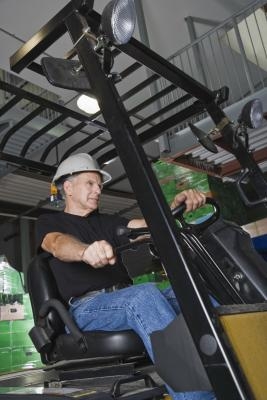
Forklifts come from a variety manufacturers, and they come in a host of configurations and sizes. Some use gas as a means to run the engines, while others might use propane. They all have basic carburetor systems that include adjustment features, such power valves, idle mixture and idle speed screws. Idle speed screws govern the rpm (revolutions per minute) of the engine while it idles. An engine that idles too low will often stall out and "load" up. An engine that idles too fast will produce harsh gear engagement, run the engine hotter and use excessive fuel. Idling down the engine requires a few basic tools and steps.
Run the forklift engine until it has reached normal operating temperature. Turn off the ignition switch. Unclasp the engine cowl snaps, raise and prop the hood. Use a socket and wrench to remove the top air cleaner cover, or twist off the butterfly nut. Remove the air cleaning element and hold it up against the sunlight.
Look through the element fibers. If you cannot see light, firmly tap the element on the pavement, end rings facing downward. This will knock most of the dust out of the fibers -- a dirty air cleaning element will not allow a proper air-fuel and idle speed adjustment. Replace the air filter element if it appears clogged and unusable. Insert the element and replace the top cover. Tighten the top cover with a socket or by hand.
Attach the negative lead clip of a tachometer to a ground source on the engine. Attach the other positive lead clip of the tachometer to the negative terminal on the ignition coil. Start the forklift engine. Refer to your service manual for the proper rpm idle speed for your engine. Look at the current rpm reading on the tachometer.
Find the idle speed screw at the base of the carburetor where it seats against the throttle lever cam. Turn the idle speed screw counterclockwise to reduce the rpm of the engine until you have reached the manufacturer's recommended rpm setting. Such a setting might indicate 650 or 700 rpm, for example.
Locate the idle mixture screw on the base of the carburetor. Refer to your owner's manual if in doubt about its location. Use a slot screwdriver to turn the mixture screw clockwise until the engine begins to stall. Turn the mixture screw counterclockwise until the engine begins to stall. Now turn it clockwise until you achieve the highest rpm rating on the tachometer. This will be the proper idle mixture setting for the correct idle speed.
Turn the idle speed screw counterclockwise or clockwise if it was affected by the mixture adjustment. This will be your final idle speed. Disconnect the tachometer leads and shut the engine hood.